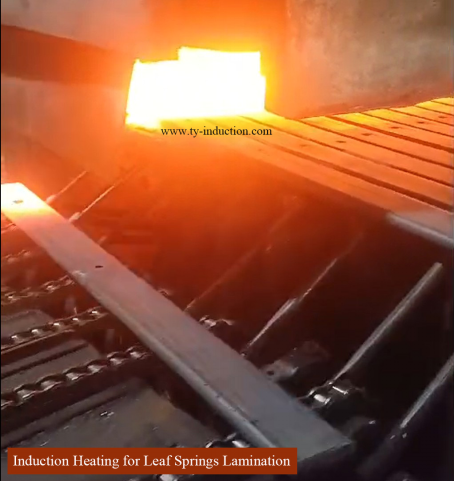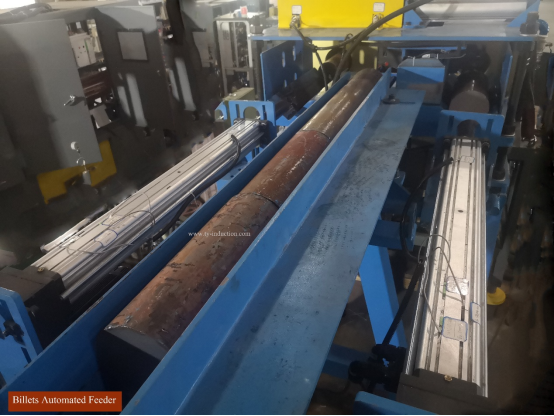Automobile Suspension System Manufacturers Use Fully Automatic Heating Production Lines to Improve Delivery Speed
September 30, 2025
With the continued growth in global demand for automotive suspension components, manufacturers of control arms, stabilizer bars, steering knuckles, spring seats, shock absorber mounts, leaf springs and connecting rods are facing increasing pressure to accelerate delivery speeds without compromising material integrity. In recent years, many automotive suspension system manufacturers have upgraded their production infrastructure by adopting fully automated induction heating lines, particularly those based on induction billet heating technology. These systems are designed to improve production efficiency by controlling forging temperatures, reducing operation times, and synchronizing upstream and downstream processes.

In the past, suspension components had long lead times, but today's automotive supply chain demands rapid turnaround. Original equipment manufacturers (OEMs) and Tier 1 suppliers typically expect:
Shorter cycle times per batch
Stable thermal conditions for forging-grade steel
Fewer rejects and minimal post-forging machining
Predictable logistics and on-time delivery
Many steel mills have long relied on gas-fired furnaces and manual feeding, which limits their output. Traditional heating methods have become a bottleneck due to unstable billet temperatures, surface oxidation, and heavy reliance on manual labor, thus impacting contract fulfillment and profit margins.
One of the core advances credited with boosting production velocity is the introduction of automated billet induction heating lines. These systems integrate:
Servo-driven billet feeders
Automated loading/unloading tracks
RFID or sensor-based billet detection
Real-time temperature control via pyrometers
Integrated forging press interfaces


Manufacturers using induction heating furnaces report significant improvements in product performance. As a non-contact heating method, induction heating transfers energy directly to the steel billet, rather than dissipating heat into the surrounding environment as with traditional heating methods. Unlike gas-fired furnaces, where temperature fluctuations under load can exceed ±30°C, induction forging heating systems maintain stable temperatures within ±5-10°C, even at high production volumes.
A fully automatic hot forming induction line can heat billets or bar stock in less time than conventional furnaces, aligning seamlessly with forging press cycle times.
Because the heated environment is localized within the induction coil, billet surfaces experience far less decarburization than with open-flame furnaces. This cuts finishing requirements on suspension parts such as:
Steering knuckles
Control arms
Shock absorber brackets
Engine cradle mounts
Uniform heating translates into consistent forging deformation, resulting in reduced fatigue risk for chassis components. Automotive suspension parts made from alloy steel or carbon steel benefit from stable mechanical properties.
By eliminating temperature variation and minimizing manual loading errors, automated billet heating line systems help reduce scrap generated from form cracks, bends, incomplete filling, and material brittleness.
Leading plants are deploying a range of specialized induction heating equipment, such as:
Induction billet heater (for pre-forging temperature conditioning)
Induction forging heater (for continuous feed production)
Induction heating system with inline temperature checks
Forging heating equipment for bar-to-billet conversion
These systems often operate in closed-loop networks. Operators can regulate power density, dwell time, and billet spacing through PLC or MES platforms, making it easier to meet ISO/TS/IAFT-quality requirements.
Automobile suspension producers adopting automated systems highlight several time-saving benefits:
Shorter Changeovers
Recipe adjustments for different billet diameters or lengths are handled digitally with minimal intervention.
Continuous Feeding
Instead of batch loading, the system feeds billets to the forging press in synchronized cycles, eliminating idle intervals.
Post-Heat Consistency
Downstream operations—such as trimming, heat treatment, machining, or surface coating—can commence immediately because the billet temperature range is reliable.
Many suspension plants handle medium- to heavy-duty forging of components that require both precision and volume. Automatic billet loading arms and robotic pick-and-place solutions are now incorporated alongside induction heating technology. This further reduces mismatch time between heating and forming operations.
Combined with digital process tracking, manufacturers can trace each billet’s temperature data and forging batch records. This is invaluable for safety-related suspension parts used in high-speed vehicles and commercial fleets.
By shifting to automated heating lines, producers have:
Reduced their average lead time by 10–25%
Decreased the variability in delivery batches
Improved just-in-time (JIT) supply chain reliability
Enhanced scheduling accuracy for OEM customers
These improvements directly influence contract retention, supplier scorecards, and long-term order flow.
The move to advanced heating systems also intersects with cost and environmental goals:
Lower fuel costs compared to gas-fired furnaces
Less waste heat and reduced ventilation demands
Lower CO₂ emissions due to efficient conversion of electrical energy
Extended forging die life due to accurate heating
With national and regional carbon regulations tightening, induction-based forging heating equipment helps plants demonstrate compliance while accelerating production.
Although not always made public, multiple automotive suspension component suppliers have acknowledged that automated induction heating lines have helped them endure volatile market demands. Plants in East Asia, Europe, and North America are particularly active in upgrading legacy equipment.
Commonly reported outcomes include:
30% reduction in billet temperature deviation
Up to 40% reduction in reheating-related downtime
Fewer forging press jams due to regulated billet positioning
Greater throughput during peak automotive release cycles
The automotive suspension sector continues to prioritize lightweight design, alloy diversification, and flexible production lines. Fully automated induction-based heating systems support all three goals. As EV platforms rise and global markets demand faster replenishment cycles, forging plants must rely on technologies that provide high repeatability and minimal downtime.
Even smaller suppliers are assessing partial or phased conversions—starting with induction billet heaters or compact induction forging heater modules—before scaling up to a complete hot forming induction line.
To help suspension system manufacturers accelerate production, TY INDUCTION provides advanced induction heating solutions engineered for forging applications. Their product lineup includes induction billet heaters, induction forging heater systems, automated billet heating line configurations, and high-efficiency induction heating furnace modules. By combining precise temperature control, energy-efficient operation, and seamless press integration, TY INDUCTION enables faster delivery schedules with significantly lower reject rates.
For manufacturers looking to expand capacity, enhance metallurgical consistency, and comply with modern environmental standards, TY INDUCTION offers design consultation, pilot testing, and turnkey installation to align current and future production goals.
Q1: What is an induction billet heater, and why is it used in suspension component production?
A1: An induction billet heater is a device that uses electromagnetic fields to heat metal billets quickly and uniformly. In automotive suspension manufacturing, it ensures that components such as control arms, knuckles, and stabilizer bars reach precise forging temperatures, reducing defects and improving throughput. Compared to traditional gas-fired ovens, it offers faster heating, lower energy consumption, and minimal oxidation.
Q2: How does an automated billet heating line improve delivery speed?
A2: By combining induction heating with automated material handling and real-time process monitoring, an automated billet heating line synchronizes billet temperature with forging press cycles. This reduces idle time, accelerates the forging process, and minimizes delays caused by manual handling or reheating, enabling faster order fulfillment for OEMs.
Q3: Can induction forging heaters handle different steel grades used in suspension systems?
A3: Yes. Modern induction forging heater systems are modular and programmable, allowing operators to adjust frequency, power, and dwell time according to steel grade, billet diameter, and length. This flexibility ensures consistent metallurgical quality across diverse alloys such as high-strength carbon steel and alloy steel.
Q4: What are the energy and sustainability benefits of induction heating furnace systems?
A4: Induction heating focuses energy directly on the metal, minimizing waste heat and reducing overall electricity consumption. This lowers CO₂ emissions compared to gas-fired heating, supports compliance with environmental regulations, and contributes to corporate ESG initiatives. Additionally, reduced oxidation lowers finishing costs, further improving resource efficiency.
Q5: How do hot forming induction lines integrate with existing forging presses?
A5: Automated hot forming induction lines can be configured with servo-driven feeders, conveyors, and sensors to match the speed and cycle of forging presses. Closed-loop temperature control ensures billets arrive at the press with optimal thermal conditions, reducing scrap and enhancing die life.
Q6: What maintenance and training considerations should plants keep in mind?
A6: Induction heating systems require periodic coil inspections, calibration of temperature sensors, and preventive maintenance of automation components. Operators should be trained on system monitoring, safety protocols, and process adjustments to ensure consistent performance. TY INDUCTION provides comprehensive training and service support for smooth integration.
Q7: Is induction heating cost-effective for small- to medium-sized suspension manufacturers?
A7: While the initial capital investment may be higher than traditional gas furnaces, automated induction heating lines often pay for themselves quickly through reduced scrap, lower energy costs, faster throughput, and improved delivery performance. Even smaller manufacturers can start with a single induction billet heater or a compact line before scaling up.
Q8: How does TY INDUCTION support manufacturers in implementing these systems?
A8: TY INDUCTION offers turnkey solutions, including induction billet heaters, induction forging heaters, automated billet heating lines, and hot forming induction lines. Their team provides feasibility studies, simulation, pilot installations, process optimization, and ongoing technical support, helping manufacturers reduce reject rates, improve delivery speed, and comply with environmental standards.
Hot Products
Contact Us
Enquiry hotline:
+86 135 4128 7190
Email:
Address:
No.18,14th Floor, Building 2, No. 169 Zhongli Road, Banzhuyuan Subdistrict, Xindu District, Chengdu, Sichuan, China, Code:610000
